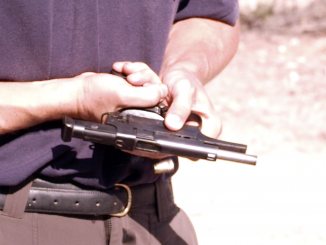The Japanese Army and Navy of the 1920s and 30s often used quite different equipment, and had a substantial interservice rivalry. Flare guns were one example of this separation, with the services using not just different flare pistols, but totally different flare cartridges. The Navy used a 28mm flare (mostly in double and triple barreled launchers like we saw last week), while the Army used a 35mm flare mostly in single barrel launchers like this Type 35.
Perhaps the most interesting aspect of the Type 10 flare pistol is its similarity to the Type 26 revolver, with which is shares a number of distinctive features including the grips, spurless hammer, and trigger guard. These flare pistols were typically issued in leather holsters, but towards the end of the war a substitute type made of rubberized canvas was also issued – one of which is being sold with this Type 10.



“similarity to the Type 26 revolver, with which is shares a number of distinctive features including the grips, spurless hammer, and trigger guard.”
This might be inspiration from Great Britain, as they during Great War used (among others) Harrington & Richardson flare guns having common parts with Webley Mk VI revolver, photo: http://ww1.milua.org/images/harrington-richardson.jpg
from: http://ww1.milua.org/signalPistol.htm
Imperial Russia during Great War also used flare guns having common parts with Smith & Wesson revolver, see 3rd or 4th or 5th or 6th or 7th photo from top here:
http://rubooks.org/book.php?book=4755&page=9
Technical data for such flare gun made by А. И. Кузнецов works in Tula:
caliber: 26,6 mm length: 210 mm height: 155 mm mass: 1,03 kg
108 examples were produced in year 1916
It wouldn’t take a lot of inspiration to think of reusing existing tooling and parts for a relatively low volume product. It’s a very sensible idea and it doesn’t surprise me at all.
“Navy used a 28mm flare (mostly in double and triple barreled launchers like we saw last week)”
2nd photo from top: http://www.nambuworld.com/fgflareguns.htm shows Japanese sailors firing flare guns, interestingly they use two-handed method. I am not sure if it is low quite or they actually stare at launched flares?
So far I know, at least in Germany during World War II proper way was to NOT stare at launched flare, so proper technique is shown at photo:
http://www.muzeumwp.pl/dictionary/pistolety-sygnalowe-wehrmachtu,245,duzy.jpg
from http://www.muzeumwp.pl/emwpaedia/pistolety-sygnalowe-wehrmachtu.php
“35mm flare”
I start wondering why they chose that caliber? Also it would make more sense if IJA would have smaller flares and IJN bigger, not in reverse.
Imperial Russian tested for naval usage 35 mm flare gun (named: Сигнальный пистолет системы Бэра) after experience gained during Russo-Japanese War, see 1st photo from top: http://ww1.milua.org/signalRus.htm
According to http://www.usmilitariaforum.com/forums/index.php?/topic/107178-wwi-35mm-aviators-flare-pistol/
35 mm flare guns were used by French aviation during Great War
“triple”
BTW: In 1870s Russian Navy tested 37 mm flare revolver:
http://www.bloha.info/view/articles/1026255/
it has capacity 5 and was designed to be used when mounted – mass was 9,5 kg so it would make rather unwieldy handgun (in that times default method was usage of single hand)
I hope nobody got shot by a flare gun. Burning to death is not by any means pleasant! And at least one FW190 pilot was taken prisoner at flare point after landing on the wrong airfield. He thought he was in France until a hopping mad Royal Air Force officer jumped on the wing and pointed a flare gun at the cockpit. It was too late to escape by that point! I could be wrong…
Watch the last fifteen minutes of the movie The Final Countdown (1980) to see what can happen when a flare “goes off” inside a Sikorsky Sea King.
cheers
eon
According to https://en.wikipedia.org/wiki/Flare_gun#Use_as_weapons
Towards the end of World War I during the Final Offensive of the Sinai and Palestine Campaign, on 19 October 1918 a German aircraft was destroyed on the ground by firing a Very light into the aircraft. The D.F.W. two-seater was first seen in the air; the first German aircraft since aerial fighting over Deraa on 16 and 17 September just prior to the beginning of the Battle of Sharon. The two-seater was forced to land and was destroyed after the German pilot and observer had moved to safety.
Len Deighton’s book on the Battle of Britain has a photo of a German airman taken prisoner. At that stage of the war, the soldiers capturing him are wearing odd bits of leftover uniforms, and only one has a rifle, a Ross left over from WWI. The flair pistol captor may have had to borrow it in order to have something to point at the pilot.
The pilot who landed the FW190 in the wrong country and was captured with a flare pistol was Armin Faber. He has his own wiki page because of the incident. The page also includes the following tale about the officer that escorted him to captivity and gun safety:
‘Atcherley, fearful of an escape attempt, aimed his revolver at Faber for the entire journey. This was possibly unwise as at one point the car hit a pothole causing the weapon to fire; the shot only narrowly missed Faber.’
https://en.wikipedia.org/wiki/Armin_Faber